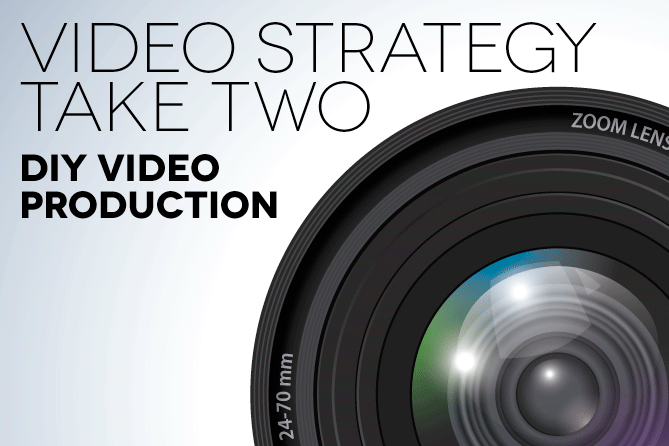 In Video Strategy Take One: Ask Yourself Five Questions, I wrote about the important questions to answer about your video project before speaking with a video production company. And while those answers could be used to design a creative brief for a professional production company, they can also be considered the first step in a do–it-yourself video project. As a video beginner, your self-produced video might not be as polished as one produced by a professional who has been in the business 20 years. That’s okay! If you understand your audience and want to educate them, you’ll know the message and visuals that will help to engage them. I’m going to assume you have the basics – a camera, a microphone and some kind of editing software like Adobe Premiere, iMovie or Final Cut Pro. You also need one more thing. Patience. The first time around you may not end up with exactly what you had in mind, but practice makes perfect. Every video you produce will teach you something about your next video.
In Video Strategy Take One: Ask Yourself Five Questions, I wrote about the important questions to answer about your video project before speaking with a video production company. And while those answers could be used to design a creative brief for a professional production company, they can also be considered the first step in a do–it-yourself video project. As a video beginner, your self-produced video might not be as polished as one produced by a professional who has been in the business 20 years. That’s okay! If you understand your audience and want to educate them, you’ll know the message and visuals that will help to engage them. I’m going to assume you have the basics – a camera, a microphone and some kind of editing software like Adobe Premiere, iMovie or Final Cut Pro. You also need one more thing. Patience. The first time around you may not end up with exactly what you had in mind, but practice makes perfect. Every video you produce will teach you something about your next video.
LET’S GET THE BALL ROLLIN’ – video pre-production
Pre-production is the first step in the video production process. It’s where you devise a detailed plan of your complete video or series of videos. Make sure you pick one member of your team as a point person to help facilitate the production from beginning to end. Producing a video involves a lot of details. Having one person responsible for keeping everyone on task makes all the difference. If you aren’t experienced, its best to keep things simple. Going into production with a comprehensive plan makes all difference. I recommend putting together a production book that includes the creative brief, a production schedule, shot list, scripts, interview questions, prop list, crew responsibilities etc. This can be considered the bible for the project and will keep everyone organized and focused on a successful outcome.
PRETTY PICTURES – shot composition
This is video. Visuals matter. How you frame your shots will affect your story and influence the emotions of the viewer. Think about what kind of screen your users will be viewing your new video content on. If most of your viewers will be watching your video on their mobile device, tablet or computer screen, you will probably want to consider making sure your wide shots aren’t too wide. The impressive view of a mountain range might be lost on a small screen. For smaller screens, I like to frame shots a little tighter than I would for something that will be used for broadcast.
If you’ve never shot a video before, here are two tutorials that will help get you started.
The Rule of Thirds
The 180 rule
Always, always, always, shoot more footage than you need. There is nothing worse then getting into post-production editing and finding out you don’t have enough shots. If that happens, make sure you have a stash of still images to take advantage of. Depending on your shoot, you might have a 20:1 shot ratio. For every twenty video clips you may only use one of them in the finished piece.
WHAT DID YOU SAY? – audio
You can get away with low quality video but you cannot get away with low quality audio. Bad audio will make it extremely difficult to keep a viewer engaged. If you can’t understand what a person is saying or if the audio levels are over-modulated, why would anyone keep watching?
Recording your audio using only the camera microphone can cause a host of problems. When you are recording a testimonial video, the most important thing is what your on camera talent is saying. You do not want it to compete with the car that’s driving by your office window or the fan in the next room. Before you start shooting, stop for a moment and listen. Is it quiet? Is there an air conditioner on? Are the phones ringing? The more you can control your background sounds, the cleaner your audio will be. Whether you are shooting with a consumer grade video camera, DSLR, or your own iPhone make sure you invest in a microphone to be used on a separate audio track.
If you are shooting with an iPhone or iPad, check out this this video. It has some tips on improving sound with those devices.
PEOPLE MATTER – on camera talent
You’d be surprised how many professional videos are produced where a person’s tie is crooked or they’re wearing a black jacket with a black turtleneck and it looks like a floating head is talking through the screen.If you plan on using on camera-talent whether in an interview setting or as the host of their own how-to video, make sure they reflect the image you want to promote. A wrinkled shirt and messy hair can be distracting and pull focus from what a person is saying.
Also, performance energy plays an important role your video’s outcome. A low energy person speaking without passion about your nonprofit’s mission will not engage anyone. On the other hand, an extremely high energy fast talker can make it difficult for viewers to take in and reflect on what is being said. Talent who are not used to being on camera won’t know where to look or what to do. Help them understand the process. The more comfortable they are, the more natural they will act on camera. And if you need them to slow down or to add energy to what they’re saying, make sure you communicate in a productive way.
IT’S A WRAP – DIY video production
Whether you’re a nonprofit team working on an online video for the first time, or you are a more experienced beginner, the process of producing video content for your content marketing plan can be a challenge. There are two secrets. The first secret is that the more detailed your plan, the smoother the production will be. A plan frees you up to try new things in the moment and become inspired by your environment or even a happy accident. The second secret is simplicity. Producing your own video may seem a little overwhelming. Don’t start with a huge production that involves multiple shoots and a huge outlay of resources. For success, keep it simple and manageable.




Indeed, it’s a very useful article you highlighted the important facts about the video production. Kindly, also write about the Business video production. Thanks